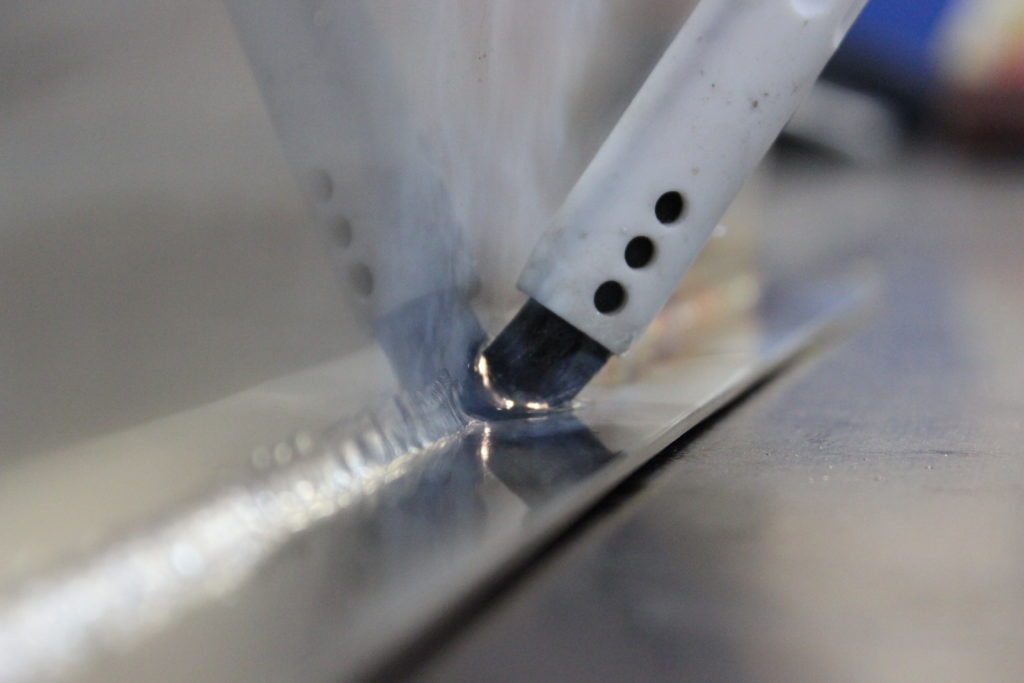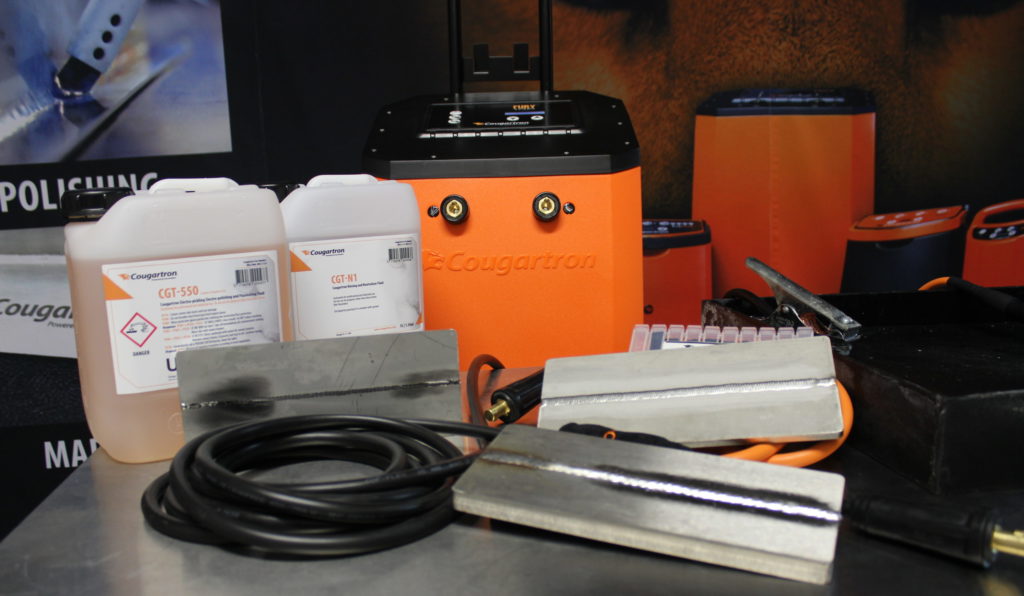Electropolishing: Theory, Application, and Industrial Use
Electropolishing | Stainless steel | Thursday, 13 June 2019
(Electro) Polishing - Why is it done?
Surface deformation, cross-contamination, and corrosion are some of the prominent side-effects of industrial metal fabrication.
To resolve these issues, we often use a combination of different metal finishing methods, polishing being one of them.
The end-goal of the process is a smooth metal surface devoid of imperfections and contaminants.
Needless to say, polishing is most applicable where improved aesthetics of finished products is a priority.
Aesthetically pleasing results in terms of improved surface reflectivity, brightness, and smoothness are achieved by utilizing a magnitude of available commercial and DIY solutions.

Here at Cougartron, we are strong proponents of electrolytic polishing.
Find out why below.
How does electropolishing work?
Analogous to similar electrolytic procedures, electropolishing uses a balanced combination of weak electrical current and mild non-dangerous fluids (electrolytes).
The metal parts are either immersed in special baths or, in our case, polished using portable machines that provide the required energy.
Electrolytic fluids are distributed over the surface using a carbon brush which also conducts the necessary amount of electricity.
The process removes a microscopic layer from the metal surface and thus solves a whole raft of problems with friction, protruded segments, crevices, scratches, dirt, residue, and indents.

Note: Electropolishing should not be confused with electroplating, a reverse process that adds a thin coating to the surface.
Electrolytic VS Mechanical Polishing
Mechanical abrasive polishing is a widespread method used traditionally in a number of industries.
Similar to electropolishing, this technique is also used to remove a portion of the metal surface and reveal its inner (base metal) structure.
However, this is mainly done with the aid of abrasive disks and the absence of a chemical reaction required for surface (re) passivation.
In addition, electrochemical polishing is done without exerting strong pressure on the surface, meaning you do not have to worry about bending and other damages often related to the use of hand tools. There is also no reduction in tensile strength when metal surfaces are polished using the electrolytic method.
The absence of dust and other flying particles is also a significant advantage of electropolishing.
Click here to read about 5 common disadvantages of abrasive mechanical polishing.
Is electropolishing suitable for all metal surfaces?
Normally, the electrolytic method is suitable for all conductive metal surfaces – stainless steel, mild steel, aluminum, copper, to name a few.
However, Cougartron electropolishing equipment is suitable for stainless steel welds and surfaces only. The reason is quite simple. By utilizing a portable power source instead of electrolytic baths, we intentionally sacrificed some of the versatility for more flexibility and improved focus on stainless steel treatment.
Metals such as aluminum require more ‘firepower’ for effective polishing and passivation.
Stainless steel is, after all, widely used and appreciated for its attractive appearance so we decided to prioritize this alloy over other metal types. When it comes to industrial production, stainless steel is, among other metals, most often subjected to electropolishing.
Electropolishing and other finishing methods
In addition to electropolishing, Cougartron machines are also capable of effective electrolytic weld cleaning and marking (All Cougartron machines can mark metal surfaces when equipped with the Cougartron Etching Set).
While marking is rather simple to single out due to its specifics, the difference between polishing and weld cleaning is sometimes hardly understood as these processes have a lot in common.
Namely, both methods can remove contaminants, passivate the surface simultaneously, and prevent future corrosion.
However, there is an important detail that sets them apart.
As noted above, polishing removes a thin layer from the surface and thus eliminates irregularities resulting from metal fabrication.
On the other hand, weld cleaning leaves the surface structure of the metal intact and only removes contamination in the form of heat tints, rust, and oxides.
Notably, our stronger weld cleaners are also capable of cleaning aluminum welds, while the polishing function is reserved for stainless steel only.
Useful tips for successful electropolishing
- The use of Cougartron machines on larger surfaces is quite impractical given that in such scenarios it is impossible to guarantee a consistent finish. Cougartron equipment is recommended for localized areas and touch-up jobs.
- Before you begin the electropolishing process, you should also take into account a number of variants such as the primary finishing method and thickness of the material.
- Thicker and coarser surfaces will require more power for successful electropolishing. The ideal choice for daily electropolishing jobs is the Cougartron FURY 100. You must also pay attention to not over polish the surface as this may obstruct its (re) passivation.
- Choose the right liquid: Electropolishing with Cougartron machines is done in combination with CGT-550 Weld Cleaning & Polishing Fluid. (The CGT-350 fluid is only recommended for weld cleaning only).

Safety standards and industrial application
Polishing is widely applied in a large number of industries where, in addition to enhancing the appearance of stainless steel, it is also used to restore its natural passive state and resistance to corrosion.
However, the benefits of this technique are especially expressed when it comes to the production and processing of food and pharmaceuticals.
In both cases, it is important that surfaces are free from different types of contaminants and highly resistant to corrosion and corrosion-provoking substances.
In the most practical sense, the importance of preventing contamination by removing metal burrs and protrusions cannot be stressed enough. In addition, a properly finished surface will collect less biological material and stop the dangerous build-up of bacteria that are a major source of concern when handling nutrient substances.
For slightly different reasons, electropolishing has found its application in the Oil & Gas industry as well.
However, it’s not only the quality of the end result that matters. Equipment and materials that come into contact with work surfaces and tools must also meet the highest international standards.
So, what’s the situation with electropolishing in that regard?
According to strict ASTM parameters and the article B912, electropolishing is suitable for precipitation-hardened alloys and different stainless steel series (200, 300, and 400).
You can read more about the standard here.
Want to know more about electropolishing?
Are you facing a specific challenge related to stainless steel finishing? Maybe you simply want to know more about the applicability of the electrolytic polishing method? Please feel free to contact us, we will gladly help you in any case.
Loading...
Please wait while the form loads.
Cougartron Polishing Equipment
Loading products...
Please wait while the products load.


 English
English  English (US)
English (US)  German
German  Danish
Danish  Swedish
Swedish  French
French  Polish
Polish  Spanish
Spanish